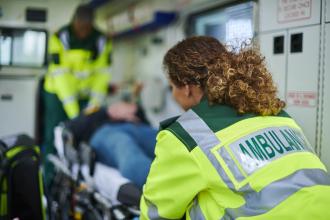Best practices in treating chronic noncancer pain
Since the mid-1990s, physicians have been increasingly prescribing higher doses and stronger opioids for their patients, particularly those with chronic noncancer pain.[1,2] Opioid overprescription, improper risk assessment, and lack of monitoring opioid medication use have led to a significant health crisis in North America. Negative consequences, including opioid dependence, addiction, overdosage, intentional or unintentional death, and diversion of drugs within the community, have impacts at both individual and societal levels. The Centers for Disease Control and Prevention reports that while death rates for conditions such as heart disease and cancer have decreased substantially over the past decade, the death rate associated with opioid pain prescription has increased significantly,[3] despite the paucity of evidence to support the use of opioids to treat chronic noncancer pain.[4,5] This increase in opioid pain prescriptions has likely contributed to the opioid crisis in which we find ourselves.
WorkSafeBC’s practical experience supports the research findings. We seldom see long-term improvements in pain and function with long-term use of opioids. Instead, strong evidence supports the use of nonpharmacological options as first-line treatments for patients with chronic noncancer pain,[6] which can be combined with pharmacological options or used on their own. The Centre for Effective Practice in Toronto divides nonpharmacological therapies into four categories:[7]
- Physical activity and exercise programs, including low-impact activities such as yoga, walking, and aquatic therapy.
- Physical therapies such as manual therapy.
- Psychological therapies such as cognitive behavioral therapy.
- Self-management programs (treatment approaches that encourage individuals to be proactive in the care of their condition through lifestyle and behavioral changes and appropriate interaction with health care services).[8]
Non-opioid pharmacological treatments can also be effective, particularly when combined with some of these nonpharmacological options.
Finding the right treatment or combination of treatments requires careful trial, monitoring, and adjustment to ensure improvements in pain and function are being achieved. While time consuming, this process is valuable to the patient.
WorkSafeBC’s best practices seminars
Throughout 2018, WorkSafeBC will host community seminars to equip physicians and nurse practitioners with current best practices in the appropriate evidence-informed management of chronic noncancer pain. Our goal is to reduce harm and improve functional outcomes. Our informative, interactive sessions (Not Just a Prescription Pad: A Multimodal Approach to Chronic Pain Management) will give you practical knowledge and skills to apply to your practice. This workshop aligns with the College of Physicians and Surgeons of BC’s standards and guidelines for safe prescribing of opioids, and physicians who attend will receive 2.5 Mainpro+ credits.
Sessions have already been held in Richmond, Burnaby, Kelowna, and Kamloops; the next session will be in Nelson on 18 June. Tentative dates for the remaining 2018 sessions are:
- 10 September: Langley/Surrey
- 25 September: Penticton/South Okanagan
- 2 October: Abbotsford/Chilliwack/Mission
- 19 October: Victoria
- 1 November: Courtenay/Comox/Campbell River
- 20 November: Delta/White Rock/Tsawwassen
All are evening sessions. Register online at http://events.eply.com/chronicpain, or call 1 877 231-8765. Seating is limited. Sessions are tentatively planned in 2019 for Coquitlam, Cranbrook/Fernie/Kimberley, Lilloo-et, Nanaimo/Qualicum, Port Moody, Prince George, Terrace, Vancouver, Vernon, and Williams Lake.
—Peter Rothfels, MD
Chief Medical Officer and Director of Clinical Services, WorkSafeBC
hidden
This article is the opinion of WorkSafeBC and has not been peer reviewed by the BCMJ Editorial Board.
References
1. Borgundvaag B, McLeod S, Khuu W, et al. Opioid prescribing and adverse events in opioid-naïve patients treated by emergency physicians versus family physicians: A population-based cohort study. CMAJ Open 2018;6:E110-E117.
2. Guy GP Jr, Zhang K, Bohm MK, et al. Vital signs: Changes in opioid prescribing in the United States, 2006–2015. MMWR Morb Mortal Wkly Rep 2017;66:697-704.
3. Rudd RA, Seth P, David F, Scholl L. Increases in drug and opioid-involved overdose deaths—United States, 2010–2015. MMWR Morb Mortal Wkly Rep 2016;65:1445-1452.
4. McNicol ED, Midbari A, Eisenberg E. Opioids for neuropathic pain. Cochrane Database Syst Rev 2013;(8):CD006146.
5. Els C, Jackson TD, Hagtvedt R, et al. High-dose opioids for chronic noncancer pain: An overview of Cochrane Reviews. Cochrane Database Syst Rev 2017;10:CD012299.
6. Babatunde OO, Jordan JL, Van der Windt DA, et al. Effective treatment options for musculoskeletal pain in primary care: A systematic overview of current evidence. PLoS One 2017;12:e0178621.
7. Centre for Effective Practice. Management of chronic non-cancer pain tool. Toronto: Centre for Effective Practice, 2017. Accessed 4 April 2018. https://thewellhealth.ca/cncp.
8. Hernon MJ, Hall AM, O’Mahony JF, et al. Systematic review of costs and effects of self-management interventions for chronic musculoskeletal pain: Spotlight on analytic perspective and outcomes assessment. Phys Ther 2017;97:998-1019.

